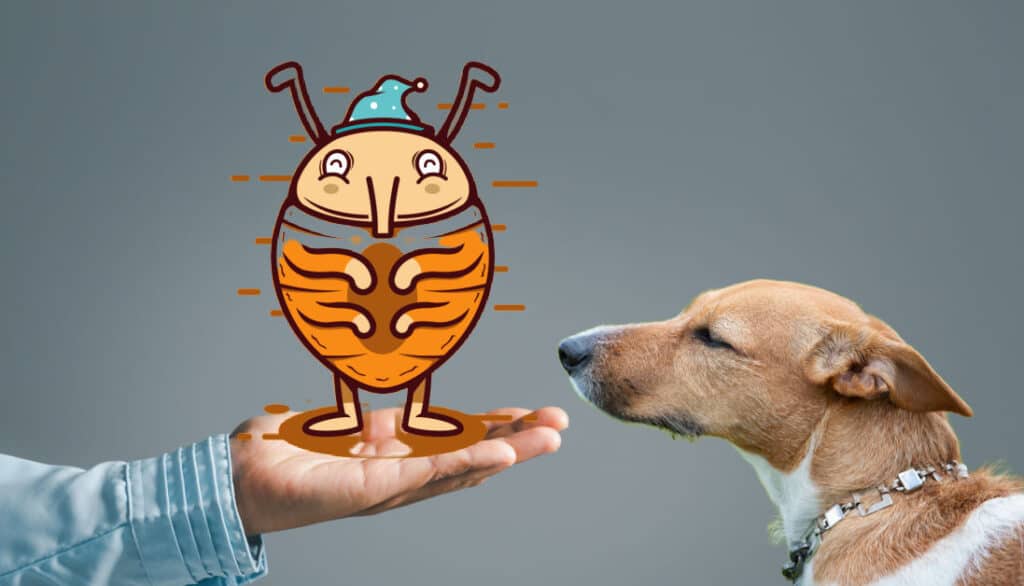Oh, the joys of dog ownership! From the playful tugs to the gentle nudges in the morning, it’s pure bliss. But, like every rose has its thorn, sometimes our furry friends come across little issues, like those pesky ear mites. If you’ve noticed your beloved pup shaking their head a bit too often or scratching their ears relentlessly, they might be sending you a signal: “Help! I think something’s bugging my ears!”
Firstly, breathe easy. You’re not alone, and more importantly, there are solutions right in the comfort of your home. In this blog, we’ll delve deep into the world of ear mites—understanding them, recognizing their signs, and, of course, some tried-and-true home remedies to give your dog the relief they deserve. So, whether you’re a seasoned dog owner or a newbie, read on. By the end, you’ll be equipped with the knowledge to bid those irksome mites goodbye!

What Are Ear Mites?
Those tiny, itch-inducing villains causing your dog distress go by the scientific name Otodectes cynotis, commonly known as ear mites. These are minuscule, spider-like parasites that live primarily in the ears of our canine companions. While they can be quite bothersome, understanding them can be the first step towards effectively addressing the problem.
The Life of an Ear Mite:
Ear mites thrive in the dark, warm environment of the ear canal, feasting on ear wax and skin oils. They have a fairly short life cycle, spanning just about 3 weeks from egg to adult. Female mites lay eggs, which hatch into larvae in about 4 days. These larvae mature, passing through a nymphal stage before becoming adults. And the cycle goes on.
Why Are They a Problem for Dogs?
Ear mites can cause a significant amount of discomfort. As they feed and move, they trigger inflammation, leading to a dark, often smelly discharge that looks a lot like coffee grounds. This can be itchy and even painful for our furry friends. Continuous scratching and shaking by the dog can lead to secondary infections or more serious complications, such as a hematoma (a swelling filled with blood) on the ear flap.
Though more common in cats, dogs aren’t spared from these tiny invaders. Dogs with compromised immune systems or those in close contact with other infested pets are especially at risk.
While these facts might make any dog owner anxious, don’t fret. Recognizing the problem is half the battle won. With a bit of care, attention, and the right remedies, your dog will be free from these microscopic pests in no time!

How Do Dogs Catch Ear Mites?
Seeing our furry pals in distress might make us wonder, “How on Earth did they catch these bothersome mites?” Let’s dive into some of the common ways dogs become the unfortunate hosts to ear mites.
1. Close Interaction with Infected Animals:
The most common way dogs catch ear mites is through direct contact with an infected animal. Play sessions, shared sleeping spots, or even a curious nose-to-ear sniff can be enough for the mites to hop from one animal to another.
2. From the Environment:
While ear mites predominantly prefer the warm confines of an ear canal, they can survive for short durations in the environment. If your dog interacts with or rests in an area recently vacated by an infected animal, there’s a chance they might pick up these unwelcome guests. Beddings, carpets, or shared grooming tools can be potential hotspots.
3. From Infested Wildlife:
Your garden isn’t just a haven for your dog to play; it’s also frequented by wildlife. If animals like foxes or feral cats with ear mites venture into your yard, they can inadvertently leave behind mites or eggs. An unsuspecting frolic in that very garden might expose your dog to these parasites.
4. Shelter or Boarding Facilities:
Dogs that have recently been adopted from shelters or have stayed in boarding facilities may have been in close proximity to other infested animals, increasing their chances of catching ear mites.
While ear mites might seem like crafty invaders, understanding their modes of transmission helps in prevention. By being observant and proactive, you can reduce the chances of your dog becoming host to these irksome critters.

Signs & Symptoms Your Dog Might Have Ear Mites
Ear mites, despite their tiny size, can cause a world of discomfort for our four-legged friends. Observing your dog’s behavior and checking for physical signs can be crucial in identifying an ear mite infestation early. Here’s what you need to keep an eye out for:
- Persistent Scratching: One of the first and most noticeable symptoms is an incessant scratching of the ears. If your dog seems to be scratching more than usual or seems agitated, ear mites could be the culprits.
- Shaking of the Head: In an attempt to get relief, dogs might frequently shake their heads. This is their way of trying to dislodge the mites or soothe the itch.
- Dark, Crumbly Discharge: Ear mites often lead to a distinctive dark, crumbly ear discharge, which looks a lot like coffee grounds. This discharge consists of a mix of blood, ear wax, mites, and their waste.
- Unpleasant Odor: The combination of the discharge and potential secondary bacterial or yeast infections can give off an unpleasant odor from the ears.
- Redness and Inflammation: The ear canal might appear red and inflamed due to the irritation caused by the mites and the dog’s constant scratching.
- Wounds or Scabs: Overzealous scratching can lead to wounds or scabs around the ear area. These, if left untreated, can become entry points for secondary infections.
- Swelling of the Ear Flap: In severe cases, the constant head shaking and scratching can lead to a hematoma, which is a swollen, fluid-filled pocket on the ear flap.
It’s essential to note that while these symptoms can indicate ear mites, they might also be signs of other ear-related issues, such as bacterial infections or allergies. If you suspect ear mites, it’s crucial to get a proper diagnosis and then pursue the best treatment route.

How To Diagnose Ear Mites In Dogs
Suspecting that your dog has ear mites is one thing, but confirming the diagnosis is essential to ensure they receive the right treatment. Here’s a look at how ear mite infestations are typically diagnosed:
- Clinical Signs and History: Often, the initial suspicion arises from the signs your dog displays, such as the incessant scratching or the presence of a dark, crumbly discharge. A recent history of interaction with other infested animals can also point towards a potential mite problem.
- Physical Examination: A vet will begin by examining the dog’s ear with the naked eye, checking for visible signs of inflammation, discharge, and any other abnormalities.
- Otoscopic Examination: Using an otoscope (a special instrument designed to look deep inside the ear), the vet will search for evidence of mites. Adult ear mites, though tiny, can be seen as white specks moving against the dark background of the earwax.
- Microscopic Examination: To get a definitive diagnosis, the vet might take a sample of the ear discharge and examine it under a microscope. Here, not only adult mites but also their eggs and larvae can be seen, confirming their presence.
- Secondary Infections: Since ear mites can lead to bacterial or yeast infections due to the inflammation and open wounds they cause, a vet might also check for these secondary issues. This will help in outlining a comprehensive treatment plan.
Why Proper Diagnosis is Important:
It’s essential to know that the symptoms of ear mites can often mimic other ear problems in dogs. For instance, bacterial or fungal infections, allergies, or even foreign bodies lodged in the ear can cause similar symptoms. Misdiagnosis can lead to inadequate treatment, prolonging the dog’s discomfort.
So, if you suspect your dog has ear mites, always consult with a veterinarian to ensure a correct diagnosis. They’ll guide you on the best course of action, be it conventional treatments or suggesting safe home remedies.

Conventional Ear Mite Treatments
When it comes to tackling ear mites in dogs, there are several conventional treatments available. While they’re effective, it’s essential to understand each treatment’s nuances to make an informed decision for your furry friend. Here’s a breakdown of standard treatments and some considerations:
- Ear Drops: Specifically formulated to target ear mites, these medicated ear drops usually contain ingredients like pyrethrins or selamectin. They not only kill adult mites but can also address eggs and larvae. The treatment typically involves applying the drops for a duration, as prescribed by the vet, ensuring the entire life cycle of the mite is disrupted.
- Miticidal Ointments: These are topical treatments applied directly to the affected ear. They aim to kill the mites on contact and are typically used once a day for a certain period.
- Injectable Medications: For severe infestations or dogs that are uncooperative with topical treatments, injectable medications like ivermectin might be recommended. However, it’s essential to note that certain dog breeds are sensitive to ivermectin, so always consult your vet.
- Cleaning and Maintenance: Alongside medications, thorough ear cleaning is crucial. This helps remove the accumulated discharge and provides relief. Some vets might recommend specialized ear cleaners that soothe the ear and maintain a hostile environment for mites.
- Treating All Pets in the Household: Ear mites are highly contagious among pets. If one pet is diagnosed with an infestation, it’s advisable to treat all pets in the home to prevent re-infestation.
Considerations:
- Possible Toxicity: Some treatments, especially if misused or overdosed, can be toxic. Always follow the vet’s guidelines and keep an eye out for any adverse reactions.
- Tricky in Young Dogs: Puppies or younger dogs might have a sensitive reaction to certain medications. Ensure the chosen treatment is age-appropriate.
- Risk to Ear Drum/Deafness: If the ear mite infestation has led to a damaged eardrum, certain medications can pose a risk. It’s essential to have the eardrum checked before treatment to avoid complications like deafness.
While conventional treatments are effective, it’s paramount to consult with your veterinarian to decide on the best course of action tailored to your dog’s needs.

3 Home Remedies For Ear Mites In Dogs
Sometimes, pet owners prefer using home remedies either as a first line of defense against ear mites or to complement conventional treatments. Natural treatments can be gentler, and you might already have some of these ingredients at home. Here are three popular home remedies:
1. Olive Oil:
- How It Works: Olive oil can smother and kill the ear mites while also providing relief to an inflamed ear. The oil can help to loosen and remove the crumbly debris caused by mites.
- How to Use: Warm up a small amount of olive oil to body temperature (ensure it’s not too hot). Using a dropper, place a few drops into the affected ear canal. Gently massage the base of the ear to ensure even distribution. Repeat once a day for a week.
- Precautions: Always check the temperature of the oil before administering it to your dog. Too hot oil can cause burns.

2. Garlic Oil:
- How It Works: Garlic has natural antibacterial and antifungal properties. When infused with oil, it can help combat ear mites and secondary infections.
- How to Use: Crush a few garlic cloves and let them infuse in olive or almond oil overnight. Strain the mixture and warm it slightly. Apply a few drops to the affected ear, massaging gently. This can be done once a day for about a week.
- Precautions: Garlic, when consumed in large quantities, can be toxic to dogs. Ensure that the dog doesn’t ingest the oil and use it only in moderation.

3. Green Tea:
- How It Works: Green tea has natural antiseptic properties that can help soothe the dog’s ear and tackle any secondary bacterial infections.
- How to Use: Brew a green tea bag in hot water and let it cool. Using a syringe or dropper, apply the cooled tea to the ear. This can also be used to gently flush out debris. Repeat once daily for several days.
- Precautions: Ensure the tea is completely cooled before using. It should be at room temperature to avoid any discomfort to your dog.
Note: While these remedies can offer relief, it’s vital to consult with a veterinarian before trying any home treatments. They can guide you on the best course of action and ensure that the remedies won’t interfere with any other treatments or existing conditions.

How To Prevent Ear Mites
When it comes to our four-legged friends, their comfort is paramount. Ensuring they’re free from the irksome presence of ear mites is crucial. Below are some effective strategies to keep those pesky mites at bay.
Regular Ear Inspections
One of the first lines of defense against ear mites is routine checks. Regularly inspect your dog’s ears for symptoms such as a dark, crumbly discharge or any signs of distress. Early detection can make treatment easier and more effective.
Prioritize Ear Hygiene
It’s not just about checking; maintaining a clean ear environment is vital. Clean your dog’s ears using a vet-approved cleaner, which can not only offer relief but also help remove potential mites or their eggs.
Isolate Affected Pets
If one of your pets is diagnosed with ear mites, separate them from other animals in the household. This isolation helps prevent the mites from hopping from one host to another, curbing the spread.
Maintain a Clean Living Environment
Ear mites can survive briefly outside their host. Ensure you regularly clean your dog’s bedding, toys, and other belongings. This routine cleaning can substantially reduce the risk of a mite resurgence.

Avoid Known Infested Animals
If you’re aware of neighboring pets battling ear mites, limit your dog’s interaction with them until they’re declared mite-free.
Embrace Preventative Measures
There’s a range of topical treatments designed to fend off various parasites, including ear mites. Consult with your vet and apply these preventative treatments as recommended.
Boost Their Immunity
A dog with a strong immune system is better equipped to fight off infections, including those instigated by parasites. Regular exercise, a balanced diet, and up-to-date vaccinations fortify your dog’s health defenses.
Limit Interaction in Risky Zones
Certain areas might be renowned for a high presence of stray animals or wildlife, both of which could be mite carriers. It’s advisable to limit your dog’s exposure to these zones.
Stay Informed
Knowledge is power. By understanding ear mites’ lifecycle, transmission methods, and symptoms, you can adopt proactive measures to ensure prevention.
With vigilance, informed care, and a routine focused on prevention, you can safeguard your canine companion from the discomfort of ear mites, ensuring their well-being and comfort.

Conclusion
Dealing with ear mites in dogs might seem daunting, but with the right knowledge and preventative measures, you can ensure your furry companion’s comfort and well-being. Remember, the key is not just to treat but to prevent. By staying vigilant, regularly checking your pet’s ears, and maintaining a clean environment, you’re already steps ahead in the fight against these pesky parasites. Your dog relies on you for their health and happiness, and by following the guidelines outlined in this blog, you’re well-equipped to provide them with a mite-free and joyful life. After all, a healthy dog is a happy dog, and there’s nothing more rewarding than seeing that wagging tail and those joyful eyes, free from any discomfort.
Frequently Asked Questions (FAQs)
Ear mites are tiny, spider-like parasites that infest the ears of pets, especially dogs and cats. They feed on the wax and oils in your pet’s ear canal and can cause a lot of discomfort.
While some symptoms of ear mites can resemble those of regular ear infections, such as redness and inflammation, ear mites often produce a distinct dark, crumbly discharge that resembles coffee grounds. If you suspect mites, it’s best to consult a veterinarian for a proper diagnosis.
Yes, ear mites can easily spread from one animal to another, especially in close contact situations. If you have multiple pets, it’s crucial to check all of them if one gets diagnosed and take preventive measures to stop the spread.
Home remedies, such as olive oil and green tea, can offer relief and might help in tackling the infestation. However, their efficacy can vary from one dog to another. While they can be used as a complementary treatment, it’s essential to consult with a vet for a comprehensive treatment plan.
While ear mites primarily affect animals, there’s a slight chance they can transfer to humans, causing itching and a rash. However, they cannot survive for long on human hosts. It’s always a good practice to maintain hygiene and wash your hands after handling an infested pet.
